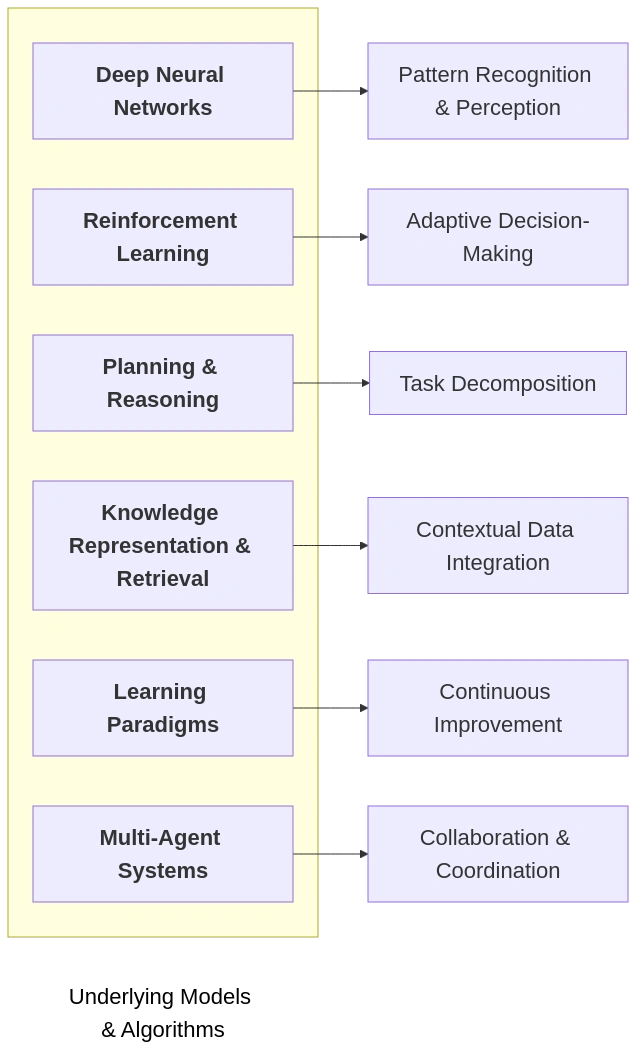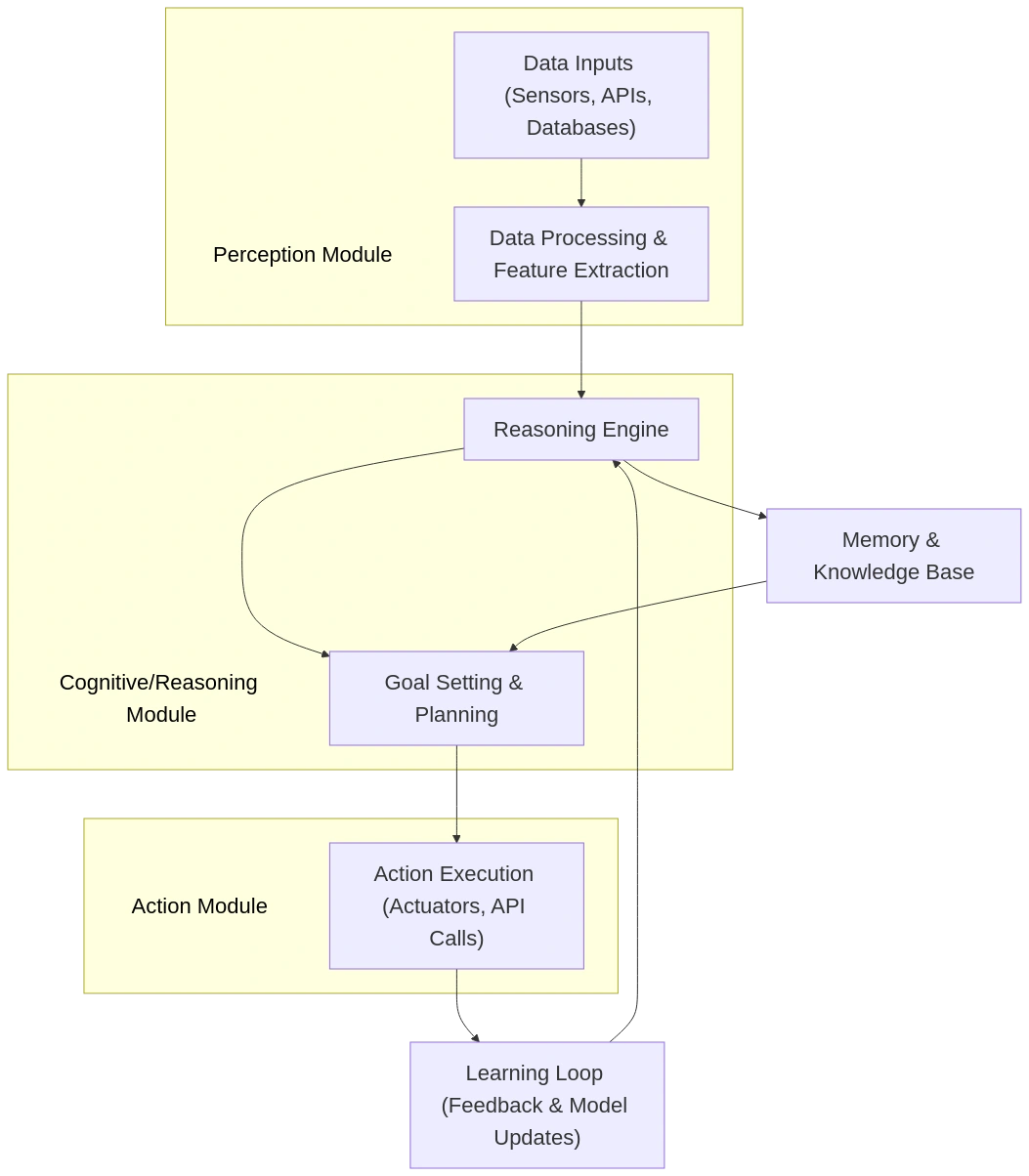Introduction
In an era of rapid digital transformation, Agentic AI has emerged as a buzzword for AI systems endowed with true autonomy. At its core, Agentic AI refers to artificial intelligence that can make independent decisions, take actions on its own, and continuously learn from experience without constant human oversight. This approach goes beyond traditional or even generative AI — agentic systems don’t just analyze data or generate content; they interpret context, reason through multi-step problems, and act adaptively to achieve specific goals. For business, the significance of Agentic AI lies in its potential to automate complex decision-making workflows — functioning as autonomous digital employees that drive productivity and innovation. LegioSoft, a software development company specializing in AI and Agentic AI solutions, is leading the charge in helping businesses harness this transformative technology.
This article demystifies Agentic AI in an accessible yet technically credible manner. We begin with a brief historical journey through AI development, then explore the technological underpinnings that enable AI agents to perceive, reason, and act autonomously. We also examine real-world applications across industries such as Real Estate, Education, and Technology, and we outline key regulatory and ethical considerations. Finally, we discuss the challenges ahead and future trends in Agentic AI, helping you make informed strategic decisions about integrating these advanced systems into your business.
Background & Historical Context
Agentic AI is not a sudden innovation but rather the culmination of decades of progress in artificial intelligence. Early AI systems in the mid-20th century were relatively static, following explicit rules and requiring detailed human instructions. Concepts such as the Turing Test and early chatbots set the stage for understanding machine intelligence. In subsequent decades, AI research evolved through rule-based expert systems — powerful for certain tasks but limited by their inflexibility.
The breakthrough came with the introduction of reinforcement learning in the late 1980s, where an agent learns optimal actions through trial and error by receiving rewards or penalties. This paradigm shift paved the way for perceiving AI systems as autonomous agents capable of decision-making. The 1990s saw the emergence of intelligent agents that could perceive their environment and act upon it, although still within narrow domains.
With the advent of machine learning and, later, deep learning in the 2000s, AI systems began to learn patterns directly from data, leading to applications such as IBM’s Watson, which demonstrated the power of AI in understanding natural language. The deep learning revolution of the 2010s further pushed the boundaries, culminating in generative models that could produce human-like content. Yet, these systems remained reactive.
Today, in the 2020s, we are witnessing the rise of Agentic AI — systems that operate with high-level autonomy. These agents can set long-term goals, plan multi-step tasks, and adjust actions on the fly. This evolution represents a leap from mere data prediction to true autonomous action, enabling businesses to automate entire workflows without human micromanagement.
Technical Explanation
Underlying Models & Algorithms
Agentic AI systems integrate multiple AI techniques to achieve autonomy:
- Deep Neural Networks: These models provide the ability to recognize patterns in data, enabling the “perception” part of the agent. They allow an AI to process images, speech, and text, offering the intuition necessary for real-time decision-making.
- Reinforcement Learning: This framework trains an agent by rewarding desirable behaviors and penalizing undesirable ones. Much like how humans learn from trial and error, reinforcement learning empowers AI to develop strategies and optimize decisions without explicit instructions for every situation.
- Planning and Reasoning Algorithms: Beyond reactive responses, Agentic AI employs planning techniques that allow the agent to simulate and evaluate multiple action sequences before executing a plan. Modern approaches even use large language models to break down complex goals into actionable sub-tasks.
- Knowledge Representation & Retrieval: Many agentic systems incorporate extensive knowledge bases, enabling them to retrieve up-to-date, domain-specific information to ground their decisions in relevant context.
- Learning Paradigms: A combination of supervised, unsupervised, and reinforcement learning techniques ensures that the AI continuously adapts to new data and evolving circumstances, thereby refining its decision-making capabilities over time.
- Multi-agent Systems: In some cases, multiple AI agents work collaboratively or competitively to achieve larger objectives. Coordination algorithms, including techniques from game theory and distributed computing, allow these agents to interact efficiently.

System Architecture
A typical Agentic AI system follows a modular design built around a “sense-think-act” cycle:
- Perception Module: This component gathers raw data from diverse sources — whether sensors in a physical environment or digital data from APIs and databases — and processes it to extract actionable insights.
- Cognitive/Reasoning Module: Often considered the “brain” of the agent, this module interprets the information, sets goals, and plans a sequence of actions. It includes a reasoning engine, planning algorithms, and decision-making components that work together to determine the optimal course of action.
- Action Module: Once a decision is made, the action module translates it into real-world effects. In robotics, this may involve actuating motors; in software, it might involve triggering an API call or updating a database.
- Learning (Feedback) Loop: This continuous loop evaluates the outcome of actions, updates the internal models, and refines the agent’s policies. The feedback mechanism is essential for ensuring the agent improves its performance over time.
- Memory and Knowledge Base: A dedicated repository stores historical data and learned insights, ensuring the AI’s decisions are informed by past experiences and evolving domain knowledge.

Applications & Use Cases
Agentic AI is already transforming industries by automating decision-making, optimizing workflows, and enhancing personalized experiences. Below are key examples of how Agentic AI is making an impact in Real Estate, Education, and Technology & AI.
Real Estate
- Predictive Pricing & Valuation: AI agents analyze market trends, historical property data, and local economic indicators to generate dynamic pricing models and accurate property valuations. This empowers real estate professionals to set competitive listing prices and make informed investment decisions.
- Virtual Tours & Intelligent Chatbots: Autonomous AI systems can conduct interactive virtual property tours using computer vision and natural language processing. These agents guide prospective buyers through detailed property insights, answer inquiries in real time, schedule viewings, and initiate follow-ups, creating a seamless customer experience.
- Automated Property Management: For property managers, AI agents can monitor maintenance needs, predict when repairs are necessary, and streamline tenant communications. This automation leads to more efficient operations and enhanced tenant satisfaction.
Education
- Personalized Learning Paths: AI agents assess individual student performance, learning styles, and progress to create customized educational plans. This adaptive approach ensures that each learner receives tailored content, improving academic outcomes.
- Virtual Tutoring & Teaching Assistants: Intelligent tutoring systems interact with students to provide real-time feedback, answer questions, and offer supplemental guidance. These virtual assistants alleviate the workload on educators while ensuring students have timely support.
- Automated Administration: Agentic AI can streamline administrative functions such as scheduling, grading, and enrollment processing. This reduces manual workload and errors, allowing institutions to focus more on delivering quality education.
Technology & AI
- Autonomous IT Operations: In tech companies, AI agents manage data centers, monitor system performance, and optimize resource allocation. They proactively identify and resolve issues, resulting in improved system reliability and cost savings.
- Software Development Automation: Agentic AI assists in coding, debugging, and deployment processes. By automating routine tasks, these agents free up developers to focus on complex challenges and creative problem-solving, thereby accelerating the software development cycle.
- Accelerated Research & Development: In the realm of AI, autonomous agents are used to experiment with new algorithms and optimize machine learning models. This iterative, self-improving process speeds up innovation and contributes to advancements in technology.
Cross-Industry Synergies
The capabilities of Agentic AI in one domain often complement those in another. For instance, intelligent data analysis and automated customer interactions developed for real estate can be adapted for educational platforms and IT operations. As organizations continue to integrate Agentic AI into their processes, cross-industry innovations are likely to emerge, leading to more interconnected and efficient AI ecosystems.
Regulatory & Compliance Considerations
As Agentic AI systems become integral to core business operations, regulatory and compliance issues are gaining importance. Key considerations include:
- Evolving Regulations: Governments worldwide are drafting regulations that target automated decision-making systems. Businesses must prepare to conduct regular audits and risk assessments, particularly in high-stakes areas such as credit decisions and healthcare.
- Data Privacy: AI agents must comply with data protection laws like GDPR and HIPAA. This requires that data collection, processing, and storage be handled with strict adherence to privacy principles, including data minimization and user consent.
- Accountability and Governance: Establishing clear governance frameworks is critical. Businesses must define who is accountable when an AI agent makes a decision and implement robust oversight mechanisms, such as human-in-the-loop approaches, especially for high-risk applications.
- Transparency and Explainability: Regulatory guidelines increasingly require that AI decisions be explainable. Techniques in explainable AI (XAI) are evolving to offer clear insights into how decisions are made, thereby fostering trust among users and regulators alike.
- Bias and Fairness: Regular audits to detect and mitigate bias are essential. Ethical AI practices must be integrated into every stage of development to ensure that decisions are fair, transparent, and free from discriminatory patterns.
Challenges & Future Directions
Current Challenges
- Technical Complexity: Building truly autonomous agents remains challenging. Many current systems are optimized for narrow tasks and require significant engineering to integrate multiple AI components seamlessly.
- Explainability and Trust: The “black box” nature of many AI models makes it difficult to understand and trust their decisions. Enhancing transparency is critical to gaining acceptance among business leaders and regulators.
- Data and Training Requirements: Effective agentic AI systems demand vast amounts of high-quality data. Continuous training and updating are necessary to ensure agents perform reliably in dynamic environments.
- Integration with Legacy Systems: Merging advanced AI systems with existing business infrastructure poses technical and security challenges that must be carefully managed.
Future Opportunities
- Algorithmic Improvements: Advances in meta-learning, transfer learning, and hybrid models promise to create more general-purpose agents capable of adapting to diverse tasks.
- Human-AI Collaboration: Future systems will likely emphasize augmented intelligence, where AI agents work alongside humans — handling routine tasks while leaving complex decisions to human expertise.
- Multi-Agent Ecosystems: We can anticipate ecosystems of AI agents that communicate and collaborate across organizations, optimizing complex supply chains and service networks in real time.
- Standardization and Regulation: As regulatory frameworks mature, the certification and standardization of AI systems will not only improve safety but also build market confidence in agentic AI solutions.
- Hardware Advances: Specialized AI hardware will reduce latency and costs, making real-time, edge-based agentic AI more practical and widespread.
For forward-thinking businesses, the key is to experiment with bounded autonomy — deploying AI agents in well-defined, low-risk areas first and gradually expanding their roles as confidence and reliability increase.
Conclusion
Agentic AI represents a profound shift from traditional AI—transforming technology from passive tools into proactive, autonomous partners. For business leaders, this means the potential to automate complex processes, improve operational efficiency, and unlock new revenue streams. However, successful implementation requires a balanced approach that combines cutting-edge technology with rigorous governance, ethical oversight, and robust integration with existing systems.
By understanding the evolution of AI, the technological foundations of agentic systems, and the critical regulatory and ethical frameworks needed to support them, decision-makers can position their organizations at the forefront of innovation. Companies that embrace Agentic AI responsibly are set to redefine the competitive landscape — turning autonomous AI agents into strategic assets that empower human talent rather than replace it.
As you consider integrating Agentic AI into your business, remember that this journey is as much about transformation as it is about technology. With thoughtful planning, ongoing learning, and a commitment to ethical practices, Agentic AI can become a powerful ally in your organization’s success story.
References
- LegioSoft Whitepaper on Agentic AI – Insights into autonomous AI systems and their business applications.
- Sutton, R. S. & Barto, A. G. (2018). Reinforcement Learning: An Introduction – A foundational text on reinforcement learning and decision-making in AI.
- Turing, A. (1950). Computing Machinery and Intelligence – The seminal work that laid the groundwork for modern AI.
- IBM Watson and the Evolution of AI Systems – A comprehensive review of AI development, from rule-based systems to autonomous agents.
- European Union AI Act & Regulatory Guidelines for Autonomous Systems (2023 Draft) – Current regulatory frameworks and compliance considerations for autonomous AI.


